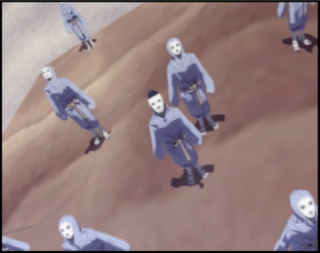Overview
Shin Megami Tensei is a sub series of the Megami Tensei franchise in Japan. In Japan this does not include Digital Devil Saga, Devil Summoner, or Persona. But in North America, Shin Megami Tensei covers all MegaTen releases.
 Screenshot from Shin Megami Tensei: Nocturne.
Screenshot from Shin Megami Tensei: Nocturne.In translation, Shin Megami Tensei literally means "True Goddess Metempsychosis." Philosophical jargon, "metempsychosis" refers to the unending process of birth, death, and rebirth, which is prevalent in Buddhist thought and this belief is featured quite heavily in the story line of many SMT games. Although that is the literal meaning, the meaning understood by western fans of the franchise is "The Resurrection of the Goddess". The title is taken from the original game in the Megami Tensei franchise, Digital Devil Monogatari: Megami Tensei; a game in which one of the primary characters, Yumiko Shirasagi, is the reincarnation or rebirth of the goddess Izanami in human form.
The original Shin Megami Tensei was the third in the Megami Tensei series, following the Famicom releases of the original Megami Tensei and Digital Devil Monogatari: Megami Tensei II. Shin Megami Tensei first appeared on the Super Famicom in 1992. The game was followed by two more Super Famicom releases; a sequel, Shin Megami Tensei II, and a spin-off, Shin Megami Tensei: if.... All three entries were later remade for other platforms.
In 2001, Atlus released the first two Shin Megami Tensei titles on the PlayStation with a number of enhancements. The remakes introduced a "Normal" mode that reduced the difficulty for both games, while the "Expert" mode retained the original difficulty. Special FMV cinemas were included as well. The GBA remakes released in 2003 produced identical graphics to those of the PlayStation remakes, but eliminated the new difficulty level, the FMVs, and the 3D wall scrolling effect. In turn, the GBA remakes received a new Options mode that let players customize the auto-battle AI, message speed and color display.
Shin Megami Tensei: Nocturne was released in 2003 in Japan. Nocturne surprised audiences by taking advantage of the PlayStation 2 and sticking to the classic elements of SMT's storytelling. It is also the first entry in the Shin Megami Tensei series that saw an official release in North America and Europe. Shin Megami Tensei: Strange Journey, released on the Nintendo DS in North America in 2010, is, like if..., a spin-off of the series, and moves the action from the traditional setting of Tokyo to a demon-infested dimensional rift in Antarctica. On May 30th, 2012, Atlus announced Shin Megami Tensei IV for the 3DS; the latest primary entry in the series.
Log in to comment